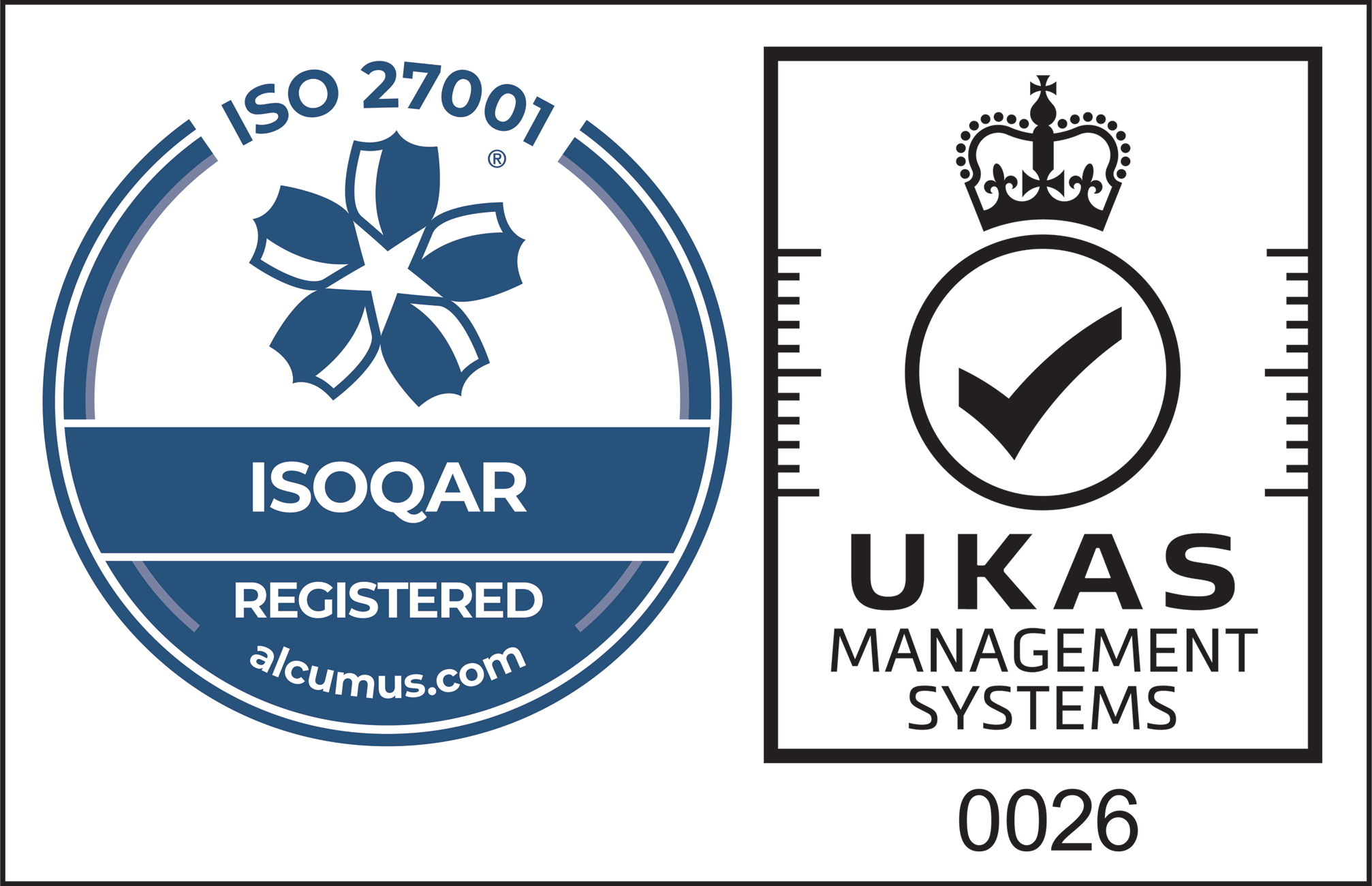Knowledge Management
– Lewis Platt, CEO – Hewlett-Packard
What Is Knowledge Management?
Knowledge management is the discipline used by organisations to optimise knowledge. It concerns the discovery, extraction, analysis, organisation, sharing and of course, management of knowledge across departments. From HR to Customer Service and Finance to Customer Experience, it is an integral business function that can significantly benefit the company, employees and customers.
In short, knowledge management seeks to make the right knowledge available to right people at the right time – and by doing do so can transform the way a business operates.
A shift in digital transformation helped companies understand the important role of knowledge within a business as well as its tremendous value. Not only does knowledge management enhance CX and customer satisfaction but it positively impacts companies internally, boosting productivity and morale.
Knowledge management deals with both explicit and tacit knowledge. Explicit knowledge is easy to communicate, analyse and document and includes data, policies and information. Tacit knowledge, on the other hand has been accumulated over years, usually residing inside the brains of senior employees, therefore it is difficult to articulate and understand, requiring far more attention than its counterpart. Tacit knowledge generally surrounds experience, perspectives and ideas, proving essential to business.
Benefits of Knowledge Management
There are a multitude of companywide benefits associated with the adoption of knowledge management, one of the most prominent involves operational efficiency. Thousands of articles of knowledge are made available to employees with a click of a button makes for faster, more efficient, more accurate decision making – and this impacts your bottom line.
Equipped with the freedom to search and find an answer to what they are looking for, employees no long have to trade emails with other teams or wait days for their superior to remember to provide them with information. When accumulated, the time spent searching for resolutions or waiting for answers is significant and is reflected in operational costs – but companies who are successfully executing knowledge management are avoiding this.
Another key driver for businesses who adopt knowledge management are their customers. Customers can indirectly benefit from your company’s utilisation of knowledge, improving the level of customer service and customer experience that they are provided and ultimately impacting on customer loyalty.
When company knowledge is successfully documented, organised and stored, what is useful to customers can be made available to them through intelligent knowledge management software. Most commonly, a knowledge base used by companies to share knowledge can be integrated with customer-facing tools such as self-service software that handles routine queries and improves customer experience. A study by Gartner revealed that as a result of deploying such software, companies experienced a 40% reduction in inbound emails and 25% head count shift away from low-value calls due to self-service. Therefore, connecting such software to a company website can not only help customers answer their own questions by automating the process, but enhance experience and therefore CSAT scores.
Furthermore, there are huge internal benefits to be reaped through knowledge management, positively impacting employees. Not only does the discipline promote a cultural shift that encourages employees to learn more, actively share their knowledge and become more transparent overall, but it can affect their morale – in a good way.
For employees, it can be frustrating when they cannot efficiently complete their tasks due to a lack of knowledge. So, when a lack of knowledge sharing leads to long waits for information and other roadblocks, employees become frustrated causing morale to drop. This is avoided through knowledge management, employees feel empowered when have full access to the knowledge they require themselves, without any potential roadblocks. It means they can do more work and potentially hit targets quicker. This has a positive impact on staff morale and in turn, can improve staff attrition rates.
Why Companies Use Knowledge Management
By enforcing knowledge management and thus a knowledge sharing culture, companies can avoid knowledge silos that are a huge challenge. Valuable knowledge is no longer hidden within teams as knowledge management encourages employees to make knowledge available and accessible to wider audiences. Time otherwise spent searching, contacting various teams and following up on information is therefore saved along with operational costs.
Furthermore, when it comes to knowledge retention, a major challenge that companies face involves employees leaving. Businesses who do not embrace knowledge management will not regularly extract knowledge from employees, so when they do leave, years of invaluable knowledge is lost with them. The effect of which includes significant hours and costs trying to replicate lost knowledge which in some cases will never truly be recovered. Knowledge management encourages regular knowledge capture, documentation and sharing across the company – when this process is conducted enough, it causes knowledge sharing to become an organic practice.
For companies operating in highly saturated markets, knowledge really is power. Having the capabilities to capture knowledge regarding customer; habits, behaviours, common problems, frequently asked questions can prove particularly beneficial. If companies know how to utilise such knowledge, using it to help inform operational and even strategic decisions, they already have a competitive advantage. Even by knowing one small piece of knowledge that competitors don’t, your company has the advantage – the power – to understand and therefore influence customers which in a highly competitive market could be the difference between success and failure.
Companies that adopt knowledge management can also benefit from utilising their knowledge internally. By storing and sharing policies, procedures, practices and guides that are perhaps unique to one department or individual, the entire company is able to ‘sing from the same hymn sheet’. HR policies, company guidebooks, brand guidelines, models and matrix’ are examples of knowledge that when shared, can help teams become more efficient. Organised knowledge like this can be easily accessed which means less time is spent requesting such information and more time can be spent on tasks – promoting operational efficiency.
Knowledge Management Process
Whether it is a company’s first time deploying knowledge management or it’s become part of a regular ritual, its crucial to follow a process. The knowledge management processes will differ from business to business, there are many variations, each with steps that carry equal weight, but in its simplest form it can be segmented into 4 categories:
- Discovery
- Capture
- Organise
- Share
Discovery
Discovery is the first step in the knowledge management process and is responsible for auditing a company’s knowledge. This is where your company finds out what knowledge is already available and documented, usually by reviewing company databases, intranets and other records. It is generally explicit knowledge that is discovered at this stage, because it is easy to understand, teach and document, it is likely to exist already.
Whist such explicit knowledge may exist, in some cases, it is inaccessible or fragmented. This is where the careful identification of existing knowledge takes places, automating the data mining process to optimise a usually time-consuming but vital step in the process.
Capture
Capture concerns the skilful extraction of company knowledge that tends to fall into the tacit category. Because tacit knowledge, that has been learnt over years and resides in the brains of employees, it is difficult to articulate, thus teach and document – it therefore warrants several techniques to effectively capture. This step is particularly complex as it involves the uncovering of knowledge that has become second nature to employees, it is time-consuming and requires skill. Companies use several knowledge capture methods to aid this step, including:
- Interviews
- Knowledge harvesting (set with senior employees to frequently capture knowledge)
- Surveys
- Retrospect (reflection meetings that are set following the completion of a project)
- Observation
Organise
Organise covers the contextualisation, analysis and storage of the now captured company knowledge. This step is key in helping employees and other relevant stakeholders comprehend and eventually use the knowledge that is made available to them – it the role of knowledge management to organise the knowledge in a way that will be consumable for the audience in mind. This step requires deep analysis in order to segment, group, unpack and combine knowledge for different audiences, into relevant categories and using appropriate media types.
This is where companies rely on knowledge management software to simplify this process, allowing for control and organisation as well as the automation and bulk editing of certain components.
Share
Share ties all preceding steps in the knowledge management process together neatly. It is essentially how knowledge is made available and accessible to those who need it – facilitated through knowledge management software.
Knowledge management provides a centralised platform for all employees to access knowledge through, offering restricted views depending on the seniority of the employee, knowledge categories and an easy to navigate search system. Knowledge articles can be effortlessly added, edited and shared with colleagues. Some knowledge management software gamifies certain elements, allowing employees to suggest new articles and if approved, encourages others to feedback.
Knowledge Management Software
Knowledge management software is the nucleus of any successful knowledge management strategy. It is used by organisations to facilitate the analysis, storage, organisation, sharing, development and management of invaluable company knowledge.
Without knowledge management software, a company simply cannot execute a knowledge management strategy.
Adopted companywide, knowledge management software works like a centralised library of knowledge that can be searched, browsed, developed and shared – all at the employees’ fingertips. Whether it’s finding an answer to a HR question for personal use, sourcing a company policy that will help resolve a customer complaint or searching for an agent script for use in a contact centre – knowledge management software caters to a myriad of business requirement and types.
A knowledge base is perhaps the most recognised knowledge management tool used by businesses who wish to optimise knowledge management. It acts as a repository of knowledge for employees and can store thousands of pieces of valuable knowledge – otherwise known as articles. Articles can contain anything that is deemed useful to a company, from employee absence policies for internal queries to product troubleshooting videos for the customer service team directly assisting customers.
Knowledge base technology is particularly popular within business because it removes the complexity surrounding knowledge management by automating and gamifying elements to enhance user experience. A knowledge base’s editor should be easy to navigate, allowing new knowledge articles to be created, edited, and linked to one another.
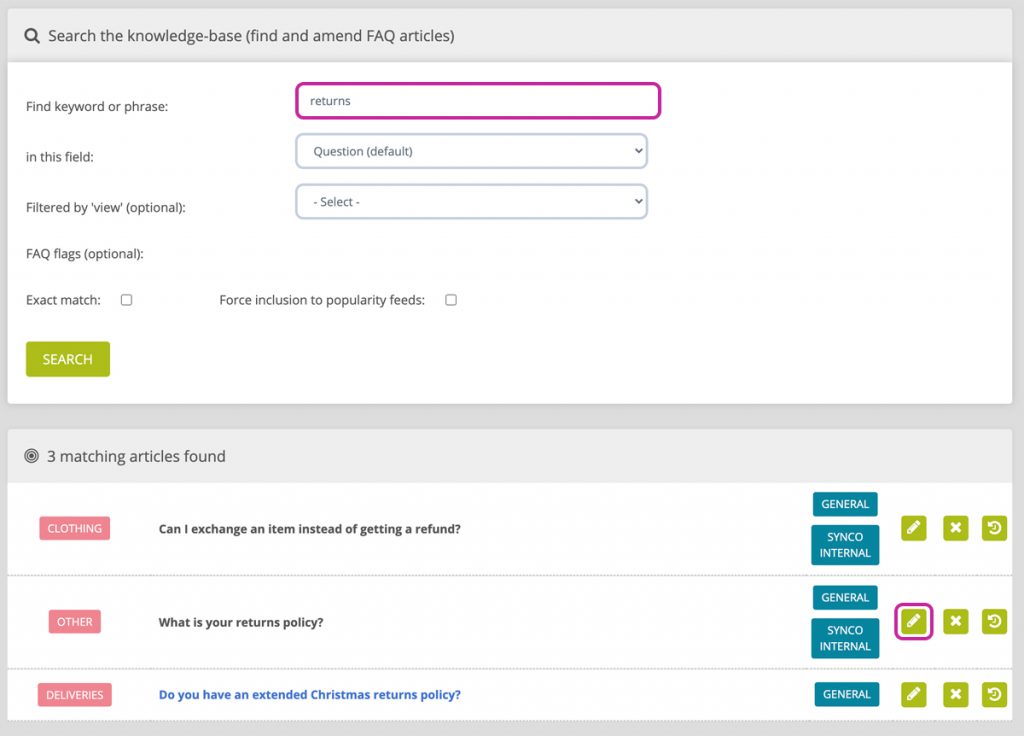
We already know that using knowledge management software like a knowledge base can empower employees, improve operational efficiency, productivity and costs, but for those whose roles are specifically customer-facing, a knowledge base proves vital. When dealing directly with customers, for instance in a contact centre, a knowledge base, otherwise referred to as agent knowledge is fundamental. Having accurate and consistent answers available at a click on a button can save agents valuable time, reducing Average Handling Times (AHT) by up to 40% (Synthetix research) and improving First Contact Resolution (FCR) rates significantly. This means more customers are successfully served, at a far quicker rate.
The beauty of good knowledge base software is that it has the capability to feed other tools that can be integral to CX success, including:
- Web self-service software
- Chatbot software
- Live chat software
Read: Why an FAQ page is not a substitute for a knowledge base.
Web Self-service Software Integrations
A knowledge base can integrate with customer-facing web self-service tools to enhance customer experience, reduce strain on contact teams and boost CSAT scores.
Web self-service software acts as a ‘do it yourself’ solution for customers to find answers to their questions. It connects to a company’s knowledge base – usually working with a restricted view – and once the searcher types their query into the search bar, AI and algorithms access the knowledge base, pulling in relevant results based on search intent. Because some customers prefer to find information out themselves and self-service software produces results instantaneously, wait times are reduced and customers are satisfied.
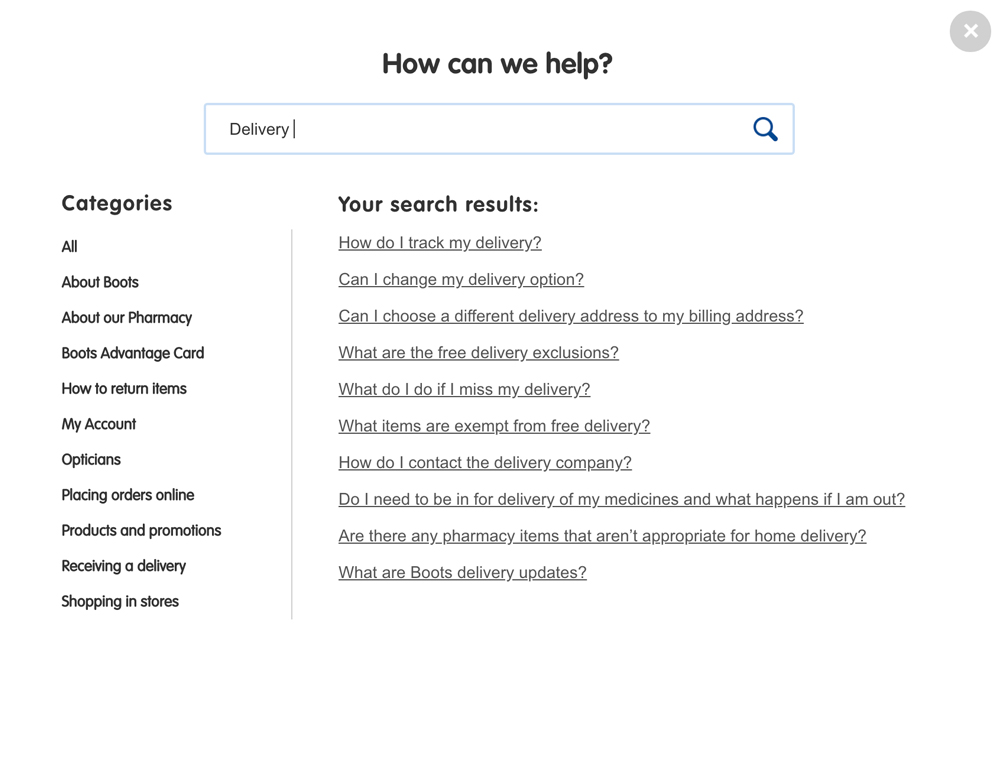
Integrating self-service software with a company knowledge base can also impact support teams considerably. Self-service can deflect up to 20% of overall contact (Synthetix research). By automating routine queries, support agents have more time to deal with complex issues, positively impacting resolution times, CSAT scores and employee morale. It also means lower operational costs as less employee time is involved – all of this however, could not be possible without a knowledge base.
Chatbot Software Integrations
Similar to the integration between self-service software and a knowledge base, a chatbot can connect to wider company knowledge to respond to customer queries, acting as a digital concierge.
The customer engages with the chatbot by typing in their question, to which the chatbot ‘replies’ in a conversational fashion. The integration allows the chatbot platform to pull the most relevant answer from the knowledge base depending on what has been typed. The main difference in how this works in comparison to the self-service integration is that the chatbot only displays one answer at a time rather than all relevant results.
Live Chat Software Integrations
A company knowledge base can also be integrated with live chat software, assisting agents in quickly providing customer resolutions. Effective live chat software includes ‘integrated knowledge’ – this is a feature within the agent interface that connects with a wider knowledge base, it takes into consideration what the customer is typing, matches keywords with articles to deliver the agent, in the same window, real-time AI-powered predictive suggestions.
You can learn more about the live chat knowledge base integration, here.
This allows the agent to be on step ahead and therefore provide the very best and accurate results quickly based on the suggestions, this not only improves first time resolution rates but it boosts customer satisfaction.
How To Create A Knowledge Base
Before creating a knowledge base, it is good practice to discuss the knowledge management objectives that underpin the company strategy with those involved in the process. Knowledge management objectives could surround:
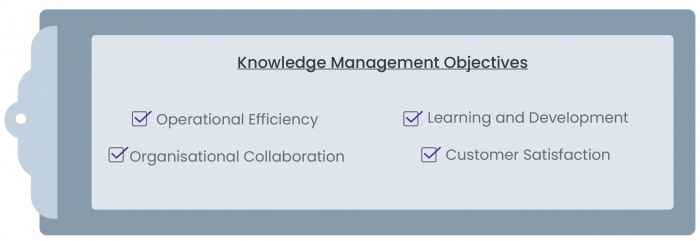
It is important that businesses break down objectives into bite size goals that involve the knowledge base, which plays a key role in the knowledge strategy. This way progress and success can be accurately measured.
It is then beneficial for a company to identify any internal challenges surrounding knowledge early on, this could help to inform the content that exists within the knowledge base, ultimately determining its structure. If knowledge silos or information hubs are a challenge within a company, a main focus for the knowledge base should be to encourage sharing by offering an easy to use sharing function. Or if employees are becoming frustrated with dealing with mundane routine queries, ensure the knowledge base software that is selected can integrate with other tools such as web self-service to automate such queries.
Once the Discovery and Capture stages of the knowledge management process have been carried out, taking into consideration any organisational needs, new and existing knowledge can be fed into the knowledge base in the form of knowledge articles.
It is best practice to first centralise all the knowledge that has been collected into one place, usually a spreadsheet. The knowledge should then break down knowledge into straightforward, digestible articles, re-writing them for simplicity and consistency of tone of voice. The more concise an article is, the better. Those who will be accessing these articles will generally be working under time-sensitive conditions, for instance, a support agent who has a customer on the phone – they don’t have the capacity to read through unnecessarily long and wordy articles – they need quick, clear answers.
Next, articles are uploaded to the knowledge base, bringing them to life. Initially, there will be a lot of knowledge to deal with, the most efficient way of uploading this knowledge is via a bulk upload feature, generally, all that is required is an XML file and your vendor should be able to assist with the rest. Thereafter, the editor tool within the knowledge base can help with adding new articles or editing existing ones.
Knowledge Management Editor
The editor tool within knowledge base software allows users to add articles by first selecting the category in which the article belongs – categories can be pre-loaded and assist with user navigation and machine learning. Next users can begin typing the searchable article title into its field, some software vendor’s intelligent systems will identify if any existing articles are using the same search terms, avoiding duplicates from being created and thus saving time.
Next, the user can create the article itself, format it, include multimedia and add relevant hyperlinks that assist the customer journey – this can prevent the customer from returning to the original contact channel to ask a related question, further optimising user experience.
Once the content is complete and styled, the editor can select a view – this is the channel in which the article can be seen and could include internal (for employees only), public (for customers to also access) or for a certain division of the business if necessary. In addition to this, companies can choose to force an article to a popularity feed if it requires exposure, or even hide from a popularity feed.
Editor Advisor Systems
Next is where it becomes interesting. Effective knowledge management vendors offer interactive advisory capabilities to check content for quality before it is submitted. This is known as an advisor system and can help improve the effectiveness of the searchable article title, suggesting recommendations and saving significant time.
The advisor system analyses the key terms by breaking down the title into search intent keywords, verbs, nouns, questions, and word stems. This is carried out using Natural Language Processing (NLP) that generates sets of bytecode mnemonics that are compared against similar customer inputs. Once analysed, the advisor system shows the user how it is processing the title. NLP will flag poorly structured titles and offer recommendations as to how to improve them, for instance, if it is too long, too short or includes irrelevant stop words.
Furthermore, once the article title been analysed, the advisor system produces the number of ‘alternative way to ask’, this includes the total number of title variations the system has discovered. The system saves these variations against the original article title so that if a customer uses one of the variations, the intended article will show up. This no code feature means that editors do not have to think of or manually enter hundreds, sometimes thousands of article title variants to ensure an article is found – saving the company significant operational resources.
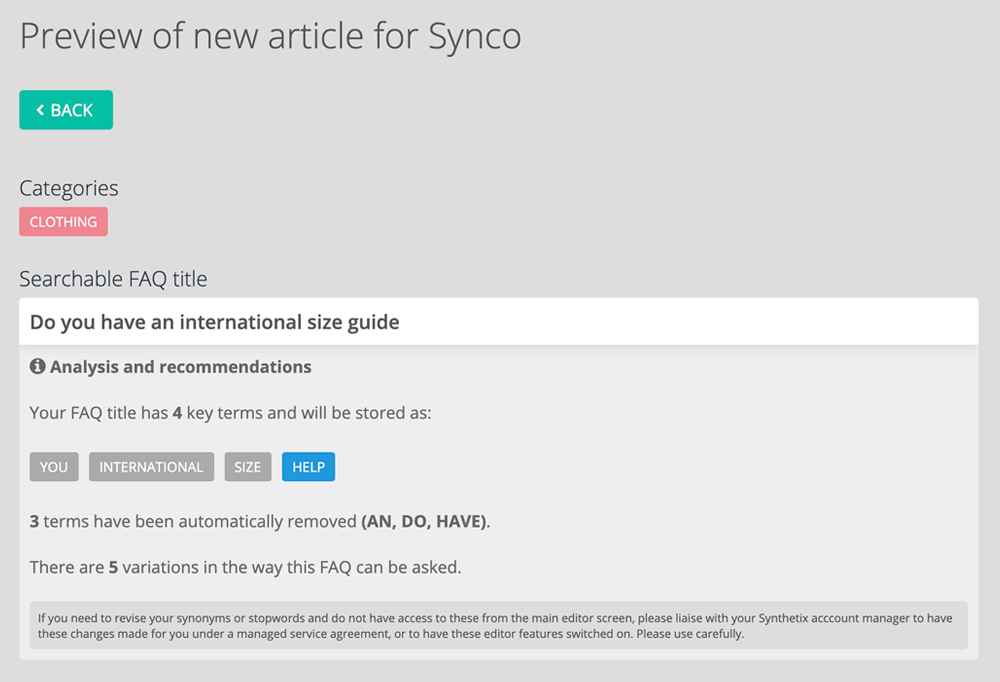
These features are considered must-haves for an effective knowledge base software and can assist in the effective execution of a knowledge management strategy.
User Navigation
When it comes to employees navigating the knowledge base, usability is vital. We know there is considerable work that goes into getting a knowledge base ready and into a state that is presentable, so it’s important not to fall at the final hurdle. Ensure the knowledge base is easy for any employee to use – searching for and sharing knowledge must be effortless and straightforward. There are several features that are included within effective knowledg base technology that can facilitate ease of use, including:
- Natural Language Processing (NLP) that breaks down search queries, isolating each word including intent-based words, grammatical quirks and idiosyncrasies to ‘understand’ naturally phrased questions and serve relevant articles
- Categories and sub-categories to help find the right information, quicker
- Filtered views to avoid irrelevant or sensitive data being accessed by all users, including customers
- Predictive suggestions that are displayed with every word that is typed into the search bar
- ‘Favourite’ function so that agents can save their frequently used articles and save time
Knowledge Management
Implementation and Integration
The implementation of knowledge management should be straightforward. There is no reason for it to be complicated or time consuming – but this will depend on the software vendor that has been selected. It is therefore recommended that companies find out vendor’s implementation practices to ensure precious time and resources won’t be wasted.
It is important that knowledge management software vendors can meet your needs for agility delivery. Find out what their average deployment times are and what their implementation blueprint is to avoid those who require multiple months of unproductive scoping activities, rather than getting you setup and working in the system. This should be a clean and simple process.
Effective software vendors will offer low-code integration for connecting customer facing tools such as self-service , chatbot , and live chat software with the centralised knowledge . This usually involves simply inserting 2 lines of code on the company website, matching the style of the site to the tool – and it is as simple as that. There is no need for complex manual html entry that the company must do themselves. Styling of the tools should be offered as a service by the vendor you have chosen to work with.
Similarly, when it comes to integrating centralised knowledge with internal tools for agents to use (otherwise known as agent knowledge software) in contact centres, the process should be easy. Software vendors simply set up secure agent logins that are compliant with the company’s security systems and provide the training that demonstrates how the software works and how it can integrate with other related tools such as live chat .
It’s important that the knowledge management software that is chosen fits in with existing software, workflows and processes. Therefore, selecting software that is built upon open RESTful APIs can prove fundamental not only to greater operational efficiency but it can give the company a certain advantage, offering a ‘360 degree’ implementation of shared knowledge across the company. Knowledge management software that is built this way allows companies to seamlessly integrate their 3rd party applications such as:
- CRM software – a customer’s chat logs and enquiries can automatically be added to the CRM platform for greater transparency and efficient account management
- Analytics tools – the integration with analytics platforms allows companies to see a full holistic customer journey from entry to exit, and everything in between using event tracking
Knowledge Management
Analytics
When it comes to measuring the success of knowledge management, a company must first consider the knowledge management goals that have been set so that they know what they are measuring against. Is the company on track? Do the goals need adjusting? Are there areas that need attention in order to achieve a certain goal? It’s vital that the knowledge management goals and objective are referred to throughout the knowledge management process, implementation and thereafter.
The other fundamental way to measure knowledge management’s success is by concentrating on metrics that surround customer outcomes and customer journeys – these will help determine how effective knowledge management is proving to the wider company, both operationally and strategically.
Customer Outcome Metrics
Measuring customer outcomes against knowledge management helps determine how well the function is working, particularly for those companies whose main interest in knowledge management is customer satisfaction. Customer outcomes can be measured using direct response feedback, which is essentially the result generated from a prompt such as “Did this article answer your question”, asked following a self-service or chatbot interaction. For companies who understand the importance of such data, having feedback mechanisms included in self-service tools is a must. Due to the large volumes of customers who tend not to leave feedback, it is difficult to look at this data alone with statistical accuracy, therefore looking at the ratio of overall people who were served versus those who gave feedback is a common method of gaging customer outcome successes.
Many will agree that there is a correlation between customer outcome successes and positive CSAT scores. The greater the frequency of customer outcome successes there are the higher the CSAT scores will be – which is logical because the more customers there are being served the information that they required, the better the customer experience is going to be and as a result, the higher the CSAT scores are.
Customer Journey Metrics
Not every company will focus all of its attention on customer outcomes, for some measuring the customer journey is a far more effective way of measuring how knowledge management is performing.
For these companies, measuring the customer journey is all about optimisation; understanding every single touchpoint to uncover issues and fix them, identifying opportunities for more efficient contact paths and even discovering upselling opportunities. All of this takes the skilful analysis of data, controlled split testing and software integrations.
By integrating knowledge management software with their chosen analytics platform, companies have a complete, holistic view of every customer journey. By setting up event tracking that is triggered once a customer engages with a contact channel, you can track each touchpoint, engagement, drop off and conversion that takes place. Other customer journey metrics that should be measured include:
- Click through rate (CTR)
- Average time spent on page
- Average time per session
- Pages per session
- Landing page behaviour
- Exit page behaviour
Equipped with this data, companies can draw conclusions based on invisible pain points and user behaviour to make decisions that can reduce operational costs, improve the customer journey, or even produce additional revenue, for example:
Scenario
1:
Data shows that customers are leaving mostly negative feedback on a high volume article. This suggests that there is something wrong with the article content and is amended to better fit the search queries. The results can later be revisited to identify if feedback has improved.
Scenario
2:
Split testing when the tool shown on different pages reveals one variant to be more efficient in terms of outcomes, user behaviour even suggests that an upselling opportunity would be a suitable fit.
Scenario
3:
Analytics show a trend in cart abandonment for a specific item and subsequent visits to the self-service page. To keep customers on the cart page, relevant articles are included and a chatbot is triggered under certain conditions asking, “Do you have any questions?”. This can assist in maintaining conversion rates.
Final Thoughts
The implementation of knowledge management shouldn’t be complicated for any company. Assign an existing member of your team as a knowledge management executive, someone who can effectively execute the knowledge management process. But the key takeaway here is that successful knowledge management cannot be carried out without the right tools. Ensure your knowledge management software is user-friendly, low code and can integrate with self-service, chatbot, live chat and other 3rd party software– because this is what turns your knowledge into power.
Choosing a software vendor that effortlessly has knowledge management up and running is crucial. The sooner the implementation is complete, the sooner employee productivity can improve and the knowledge sharing culture can develop. Contact deflection can also begin to increase through the intelligent tools you have chosen, automating the routine and allowing agents to deal with the complex – this significantly reduces operational costs. And finally, your customers have the choice to solve their own issues or engage with a chat agent or bot – either way their experience has been enhanced attributing to customer satisfaction.



